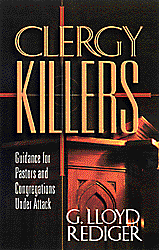
"Worse yet, there is a strong tendency toward denial of this reality in denominational offices and among clerby who have not yet been forced out of their congregations or battered emotionally and spiritually while trying to be faithful pastors.
"It is hard to believe this is happening; the church, synagogue, and temple are the last places such behavior would be expected. Even though there is abuse and violence in society, it seems incongruous that it would happen in church. The church buildings and denominational offices still look much as they have for years, and pastors preach from the pulpits every weekend. Except for occasional scandalous headlines, much of the abuse, conflict, and breakdown of pastors, priests, and rabbis is not in public view. Some of the abuse of pastors and their families may even look like normal attrition, or the familiar movement of pastors from one congregation to another, or a few incompetent pastors causing conflict. But these appearances mask an insidious trend in organized religion that I call the clergy killer phenomenon. That name is an accurate description of both the target and the agenda of this abuse. Clergy killers are terrorists.
"This book is a sincere effort to awaken the church to a nightmare coming true. I speak from the experience of many years as a pastoral counselor specializing in the pastoral care, across denominational lines, of clergy and their families. The results of my research and experience, and that of a growing number of concerned leaders, require a responsible cry of alarm and a prophetic warning. We are not just talking about conflict anymore, we are talking about emotional and spiritual abuse of traumatic proportions. And we are discovering that such abuse is exhausting pastors and draining the energy and resources of congregations and denominational programs. This is a prophetic warning, for it warns of an ancient mistake--killing the prophets--that is a forerunner to tribal and national disaster. The record of human history shows that the tribe that kills its shaman loses its soul.
"Not only does this book warn of disaster, it provides remedies and effective strategies for healing and health in the church. Church leaders must not allow pastors to die one by one and imagine that this is not a warning signal. And pastors must not allow themselves to slip into victim-thinking, in which they become pitiful shadows of a once noble profession. It will be up to pastors to break this degenerative pattern and move the church forward toward health. Pastors can use a lot of help from concerned laity, seminaries, and wise denominational officials.
"Pastors are already networking around this issue. Several organizations, such as the Ministers Mutual Aid, Inc. in Canada and the Association of Battered Clergy in the USA, are working to support and guide pastors who are being abused, as they seek relief and healthy ways to end the abuse.
"The first three chapters of this book describe the dergy killer phenomenon in detail. The next four chapters discuss the differences between the common conflicts that occur in any human organization, and the abuse and evil destructiveness now occurring in many congregations. Three types of abusive conflict are described. Then a specific method is offered for managing each one. It is important to note these different categories and methods, for many efforts at negotiation are failing to end the abuse and destruction. Because we must be honest about this abuse process, a chapter is included that describes the congregation killer--the pastor who abuses congregations. Though few in number, they too wreak their havoc.
"By this time in the book's progression, it will be natural to ask and answer the question of why people act like they do. Chapter 10 discusses a systemic design for human needs and motivations. It is a distillation of the teachings of psychologists and theologians who have attempted to answer this question. The model provided gives an understanding of what pastors must do not only for self-defense, but also to lead congregations toward healing and health.
"The themes of Chapters 12 and 13 are the reinvention of clergy support systems and the personal responsibility of pastors for their own spiritual, mental, and physical fitness; pastoral ministry is no longer a safe place for weak or incompetent pastors. These chapters are a strong effort to encourage the growing awareness among clergy that total fitness is required for effective ministry. They also remind us that such fitness need not be an ordeal. It feels great and its benefits are enormous.
"Finally, the book concludes with an upbeat description of healthy congregations and an answer to the question, What is health in the spiritual and mental sense, and how can it be achieved? There is great hope that the church will recognize this massive problem and open itself to God's healing, as it has many times before in history. But this will not occur until we can name this demonic reality, exorcise it, and replace it with wholeness. This
book is dedicated to that purpose.